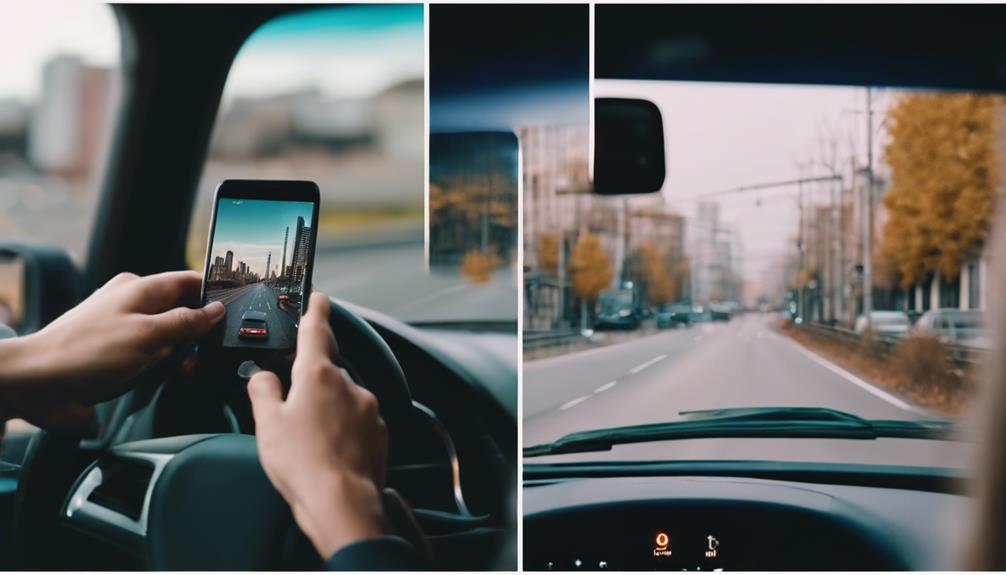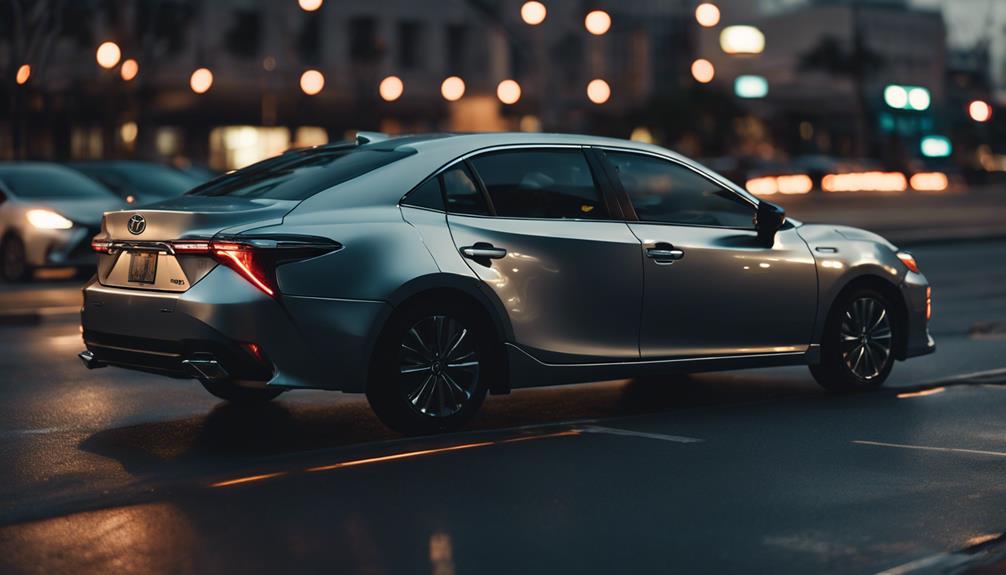Celebrity News
Toyota's 'You Don't Own Me' Commercial Explained
Harkening back to 2015, Toyota's edgy "You Don't Own Me" commercial cleverly captured Millennials' desire for autonomy, but what made it so effective?

Toyota's 2015 'You Don't Own Me' commercial successfully resonated with Millennials, garnering over 90% positive emotional comments, by tapping into their desire for autonomy and individuality. The catchy slogan and Lesley Gore soundtrack created a memorable and attention-grabbing vibe. The ad effectively targeted the 21-35 age group, establishing an emotional connection with viewers. As distracted driving continues to be a leading cause of road accidents, Toyota emphasized safety features in Corolla TV ads, highlighting the importance of lane departure warning systems. Discover how Toyota's commitment to safety technology and innovation positioned the brand as a leader in the industry.
Key Takeaways
• Toyota's 'You Don't Own Me' commercial targeted Millennials aged 21 to 35, resonating with their desire for autonomy and individuality.
• The ad's catchy, cool, and attention-grabbing vibe helped create an emotional connection with the target audience, with over 90% of emotional comments being positive.
• The commercial's message was relatable, authentic, and memorable, successfully tapping into Millennials' emotional responses and influencing their perceptions and purchase decisions.
• The ad's focus on autonomy and individuality was likely intended to distract from the actual product being advertised, which is the Toyota Corolla, featuring advanced safety features.
• The commercial's emphasis on emotional connection reflects a shift in consumer demands, where brands must adapt to changing expectations and prioritize emotional resonance in their marketing strategies.
Unpacking the Ad's Message
As Toyota's 'You Don't Own Me' commercial resonated with Millennials, it's clear that the ad's message effectively tapped into the demographic's values and sensibilities.
The Toyota Corolla ad, featuring Lesley Gore's iconic song, struck a chord with auto intenders aged 21 to 35. Over 90% of emotional comments about the ad were overwhelmingly positive, indicating a strong connection with Millennials. The ad's catchy, cool, and attention-grabbing vibe resonated deeply, generating significant brand engagement.
Millennials, known for their discerning tastes, found the ad's message relatable, authentic, and memorable. The ad's success can be attributed to its ability to tap into the demographic's desire for autonomy and individuality, values embodied in Gore's classic hit. By leveraging these emotions, Toyota successfully created an ad that not only grabs attention but also fosters brand loyalty and influences purchase decisions.
As Millennials continue to shape the automotive market, the 'You Don't Own Me' commercial serves as a prime example of effective marketing that resonates with this influential demographic.
The Rise of Distracted Driving

Distracted driving, a pervasive threat to road safety, has sparked widespread concern, prompting Toyota to emphasize safety features in its Corolla TV ads. As the number of accidents caused by distracted driving continues to rise, Toyota is taking proactive measures to address this issue.
Some key facts about distracted driving and Toyota's response include:
- Distracted driving is a leading cause of road accidents, with thousands of lives lost annually.
- Toyota's Corolla TV ads highlight the importance of safety features, such as lane departure warning systems, to mitigate the risks of distracted driving.
- The automaker is targeting busy customers who may be prone to distraction while driving, emphasizing the need for safety features.
- Safety technology, like lane departure warning, is becoming a standard feature in vehicles to reduce distracted driving risks.
- Toyota's advertising strategy for the Corolla aligns with the growing awareness around distracted driving, underscoring the brand's commitment to road safety.
Safety Features in Modern Cars

Toyota's emphasis on safety technology in their advertising strategy reflects the growing importance of safety features in modern cars.
Today's vehicles often come equipped with Crash Avoidance Systems, designed to prevent accidents by alerting drivers to potential hazards.
Additionally, many modern cars offer Advanced Safety Options, such as lane departure warnings and blind spot monitoring, to further minimize the risk of accidents.
Crash Avoidance Systems
One of the most significant advancements in modern cars is the development of crash avoidance systems, which have become a standard feature in many vehicles. These systems are designed to prevent accidents or reduce the severity of crashes by alerting drivers to potential hazards or automatically taking control of the vehicle.
Some common crash avoidance systems include:
- Lane Departure Systems, like the one featured in Toyota's Corolla ad, which alert drivers when they drift out of their lane
- Automated braking systems, which can automatically apply the brakes to avoid a collision
- Blind spot monitoring systems, which warn drivers of vehicles in their blind spots
- Forward collision warning systems, which alert drivers of potential frontal collisions
- Adaptive cruise control systems, which adjust the vehicle's speed to maintain a safe distance from the vehicle ahead
The increasing prevalence of crash avoidance systems reflects the evolving priorities of car manufacturers and consumers, who are placing a growing emphasis on safety features in modern cars.
Advanced Safety Options
As car manufacturers continue to prioritize safety features, advanced safety options have become a hallmark of modern vehicles, offering drivers an added layer of protection on the road.
Toyota's Corolla, for instance, boasts a range of advanced safety features, including a Lane Departure System, which is showcased in the company's TV ads. This feature is particularly useful for busy consumers who may get distracted while driving, as it helps prevent accidents by alerting the driver if the vehicle drifts out of its lane. In fact, lane departure warning has become a standard safety feature in many modern vehicles, including the Corolla.
With the open road ahead, having advanced safety options like automated braking systems can provide drivers with peace of mind. As the automotive industry continues to evolve, it's clear that manufacturers are committed to prioritizing safety features in their new cars.
Lane Departure System Explained

Drivers who often find themselves multitasking behind the wheel will appreciate the Corolla's Lane Departure System, designed to intervene when a driver inadvertently drifts out of their lane. This feature is particularly important for those who, like David Bowie, are always on the go, saying 'Let's go places' without compromising safety. Toyota's advertising strategy reflects a deep understanding of the customer base's safety needs and preferences.
The Lane Departure System is a key aspect of the Corolla's advanced safety features, which include:
- A camera-based system that detects lane markings and alerts the driver if the vehicle drifts out of its lane
- A gentle correction mechanism that helps guide the vehicle back into its lane
- Integration with other safety features, such as adaptive cruise control and automatic high beams
- Customizable alert settings to accommodate individual driver preferences
- Availability as a standard or optional feature, depending on the trim level and region
The Importance of Staying Alert

Stay alert, stay safe: the importance of vigilant driving can't be overstated, especially for busy individuals who often find themselves juggling multiple tasks on the go.
Toyota's 'You Don't Own Me' commercial emphasizes the importance of staying alert while driving, highlighting the dangers of distractions on the road. The ad targets busy customers who may face distractions while driving, emphasizing the need for constant vigilance.
With the rise of modern vehicles equipped with advanced safety features, lane departure warnings are becoming a standard feature. Toyota's advertising strategy reflects a deep understanding of their customer base's needs for safety, acknowledging the importance of staying alert to prevent accidents.
Toyota's Commitment to Safety

How does Toyota's dedication to safety manifest in its vehicles, and what measures has the company taken to guarantee drivers' well-being on the road?
Toyota's commitment to safety is evident in its advertising strategy, which highlights the importance of safety features in its vehicles. The company's Corolla TV ads, for instance, feature the Lane Departure System, a technology designed to prevent accidents by alerting drivers who drift out of their lane.
Toyota's emphasis on safety is a response to the needs of its customer base, who prioritize safety features in their vehicles. The company's approach reflects a deep understanding of its customers' concerns and the importance of safety innovation in the automotive industry.
Some key aspects of Toyota's commitment to safety include:
- Lane departure warning as a standard feature in vehicles
- Targeted advertising to busy customers who may get distracted while driving
- Emphasis on safety technology to prevent accidents
- Understanding of customer priorities and concerns
- Contribution to the industry trend of promoting safety features in vehicles
The Target Audience Revealed

Toyota's 'You Don't Own Me' commercial specifically targeted Millennials, aged 21 to 35, who responded positively to the ad's message.
In fact, nearly 90% of emotional comments about the ad came from this demographic, indicating a strong connection.
To better understand this audience, it's essential to examine both demographic insights and psychographic analysis, which can reveal the underlying motivations and values that drove their response to the commercial.
Demographic Insights
Millennials aged 21 to 35, a demographic known for their eclectic tastes and preferences, were squarely in Toyota's sights with its 'You Don't Own Me' commercial. This age group was strategically targeted, and the ad's success can be attributed to its deep understanding of their values and preferences.
Some key demographic insights about the target audience include:
- The commercial resonated well with auto intenders within the Millennial age group.
- Emotional comments about the ad were overwhelmingly positive among viewers.
- Millennials found the ad catchy, cool, and attention-grabbing.
Understanding Millennials' preferences and values was key to the ad's success. The ad's appeal to this demographic has contributed significantly to its overall success.
Psychographic Analysis
A psychographic analysis of Toyota's 'You Don't Own Me' commercial reveals a target audience driven by a desire for independence and self-expression. This demographic, comprising Millennials aged 21 to 35, resonated deeply with the ad's message of empowerment.
The commercial's catchy tune, cool visuals, and attention-grabbing narrative all contributed to its success in connecting with this demographic. Nearly 90% of emotional comments about the ad were positive, showcasing its impact on the target audience.
Millennials found the ad to be not only entertaining but also emotionally resonant, with many commenting on its ability to evoke feelings of independence and confidence. By tapping into the desires and values of this demographic, Toyota's commercial successfully created an emotional connection with its target audience.
The ad's focus on independence and empowerment struck a chord with Millennials, making it a memorable and impactful campaign.
A Shift in Consumer Demands

Consumers, particularly the younger generation, are increasingly seeking more than just product features and prices from advertisements. They crave emotional connections, authenticity, and shared values from the brands they support. This shift in consumer demands has significant implications for advertisers, who must adapt to meet these evolving expectations.
Some key aspects of this shift include:
- Emotional resonance is essential, as Millennials respond positively to ads that evoke strong emotions like love and amazement.
- Consumers, especially younger ones, prioritize emotional connections over product features and prices.
- Advertisements that tap into emotional responses influence Millennials' perceptions and purchase decisions.
- Understanding and meeting consumer demands for emotional connection is vital in modern advertising.
- Brands that fail to adapt risk being left behind, as consumers increasingly expect more from the brands they support.
Toyota's 'You Don't Own Me' commercial successfully tapped into Millennials' emotional responses, demonstrating the brand's ability to adapt to changing consumer demands. By understanding and meeting these evolving expectations, brands can build stronger connections with their target audience and drive business success.
Toyota's Safety Focus Strategy

Toyota's commitment to safety innovation is reflected in its Corolla TV ads, which prominently feature the Lane Departure System as a key selling point. By highlighting this feature, Toyota is emphasizing its focus on safety, which resonates with busy customers who may get distracted while driving.
The Lane Departure System is becoming a standard feature in vehicles, demonstrating Toyota's commitment to safety innovation and aligning with industry trends. Other manufacturers are also running similar ads, showcasing automated braking systems and safety technologies in their vehicles.
Toyota's advertising strategy demonstrates a deep understanding of its customer base, focusing on promoting safety features to resonate with consumers. By doing so, Toyota is positioning itself as a leader in safety innovation, a key consideration for many car buyers.
As the automotive industry continues to evolve, Toyota's safety-focused strategy is likely to remain a key differentiator for the brand.
Frequently Asked Questions
Why Does Jan on Toyota Commercials Look Different?
Jan, the familiar face in Toyota commercials, appears different because the original actress, Laurel Coppock, was replaced by her sister, Danielle.
The smooth change was achieved due to Danielle's similar appearance and demeanor, maintaining the character's recognizable traits.
Fans praised the casting choice, ensuring the character's familiar presence in Toyota's ad campaigns.
What Is the Slogan of Toyota in Australia?
Toyota's slogan in Australia is 'Oh What a Feeling,' a phrase that has been associated with the brand since the 1980s.
This iconic slogan reflects the excitement and satisfaction of owning a Toyota vehicle, highlighting the positive emotions and experiences associated with driving a Toyota.
It has become a memorable phrase, evoking feelings of joy and satisfaction among Toyota owners in Australia.
Conclusion
To sum up, Toyota's 'You Don't Own Me' commercial is a wake-up call to drivers, emphasizing the importance of staying alert behind the wheel. By highlighting the dangers of distracted driving, Toyota reinforces its commitment to safety, acknowledging that 'when it comes to safety, there's no room for compromise.'
With advanced features like Lane Departure Systems, Toyota is 'pushing the envelope' to make sure drivers stay on track, literally.
Celebrity News
J.D. Vance Didn’t Have Sex with a Couch, Still Odd
Explore the curiosities surrounding J.D. Vance, an unconventional figure who sparks interest beyond unfounded rumors.

Every day, the political world brings weird surprises. Yet, some stories catch us off guard with their strangeness. J.D. Vance’s case is one of them, revolving around a bizarre couch meme. It started from a tiny remark in his memoir, twisted into humor by Twitter user @rickrudescalves. This joke turned into a huge debate, filled with doubt and laughter. Despite clear evidence against it, the idea that Vance got too close to couch cushions spread wide. This tale shows how memes can twist political talks. As we get ready for the intense 2024 election, Vance’s couch story is a weird reminder. It shows that online rumors can grow big, mixing truth and lies.
Key Takeaways
- The J.D. Vance rumor gained traction on July 15, 2023, starting from a tweet by @rickrudescalves.
- The claim references his memoir, “Hillbilly Elegy,” yet is largely a humorous exaggeration.
- Memes proliferated on platforms like TikTok, demonstrating the virality of internet culture.
- The Associated Press published and then retracted an article debunking the rumor.
- Vance’s extreme views parallel the humor and absurdity surrounding his politically charged persona.
The Origin of the Rumor
A strange idea started from a tweet by @rickrudescalves on July 15. It said J.D. Vance did something weird with a couch. This idea turned into a well-known meme about J.D. Vance. The meme got big because it showed what’s funny and strange about internet jokes today. It even joked about Vance’s book, *Hillbilly Elegy*, but none of it was true. Social media can make fake stories seem real, especially about famous people.
The Meme Culture and Social Media Impact
Memes can be funny but also misleading, especially in politics. They can make people believe things that aren’t true. The J.D. Vance couch meme showed how powerful social media is. Simple jokes can become big topics that everyone talks about. This mix of humor and rumors can change how we see people, especially during elections.
Details of the Rumor and its Spread
The first tweet pointed to pages in *Hillbilly Elegy* with no mention of a couch incident. Yet, the story grew and mixed with Vance’s bold opinions on social issues. The Associated Press tried to clear things up with an article. But strangely, the article disappeared in a day. This shows how hard it is to keep facts straight when memes and rumors spread fast on the internet.
| Rumor Details | Findings |
|---|---|
| Origin of the Meme | Tweet by @rickrudescalves on July 15 |
| Reference in *Hillbilly Elegy* | No mention of sexual acts with a couch |
| Associated Press Response | Published article debunking the rumor |
| Article Removal | Removed within 24 hours |
| Presence of “couch” in memoir | 10 mentions, no sexual context |
| Other Statements by Vance | Known for extreme views on various topics |
Fact-checking the Couch Saga
Recently, a strange rumor about J.D. Vance made fact-checking in the media crucial. Snopes and the Associated Press worked hard to check these claims. Their efforts showed how vital true journalism is in fighting false news.
The Role of Snopes and Associated Press
Snopes, a site that fights urban legends and false information, found no truth in the charges against Vance. The Associated Press announced he was not involved in those activities. Yet, they had to take back their story due to mistakes in their process. This incident shows why it’s key for news groups to check facts well. Even small mistakes in headlines can spread the wrong information.
The Consequences of Misleading Headlines
Misleading headlines can change how people see things. The quick effort to report on Vance caused confusion and made false ideas stronger. Media outlets, without meaning to, pushed these untrue stories by being too sensational. It’s important for news to be careful in their reporting. Doing so keeps the public’s trust and prevents false beliefs. Clear fact-checking is crucial for keeping people well-informed.

J.D. Vance Didn’t Have Sex with a Couch. But he’s still extremely weird.
J.D. Vance’s story is more than just rumors. It ties into serious political issues. The couch joke shows how we mix humor with concerns about his political acts. We’re looking at how odd claims against Vance match his past.
Understanding the Context of the Meme
Vance didn’t do anything wrong with a couch. But, the tale highlights how people view him; funny, yet serious. His words and deeds have made him a figure of debate. The couch joke is a mix of fun and critique of who he is in politics.
Past Controversies and Statements by Vance
Vance has made bold statements that spark debate. He backed overturning the 2020 election and supported those involved in the January 6 event. Vance suggests big changes in government, raising questions about his democratic values. His ties to past issues and certain leaders show his provocative standpoint.

From doubting Trump to becoming his strong supporter, Vance has changed a lot. His change fuels stories about him, especially by Democrats against Republicans for elections. With the 2024 elections coming up, the couch joke stays relevant. It captures the weird and serious sides of Vance’s stance.
The Cultural Significance of the Rumor
The rumor about J.D. Vance and the couch is a key example of today’s political talk. It shows how political jokes shape what we think of leaders. Through memes and jokes online, the silly rumor becomes a big topic. This shows how people view politicians now.
What It Reveals About Political Discourse
This event shows that political jokes often mix with serious talk. As Vance moves forward politically, the jokes about the couch rumor show how we see him. This laughing matter marks a big change in reviewing public figures. People now mix humor with doubts in serious talks.
Humor and Ridicule in Modern Politics
In today’s world, political humor is an important tool. Memes quickly spread jokes about J.D. Vance. This humor is a way to deal with political worries. People create funny images and videos. This blend of fun and critique sparks conversations about politicians and their choices.

| Aspect | Details |
|---|---|
| Type of Humor | Political Satire |
| Impact on Vance | Increased Ridicule |
| Cultural Analysis Result | Shift in Public Discourse |
| Medium of Spread | Social Media Memes |
| Development of Memes | Altering Book Covers, Videos |
Public Perception of J.D. Vance
J.D. Vance’s political journey has faced many rumors, including a weird one about a couch. As he joins the 2024 race with Trump, this rumor affects his image. Strange stories like this influence what people think of Vance. Recent social media memes show how rumors can impact a candidate’s standing. They change how voters see them.
Vance’s Political Journey and Reputation
Vance has been criticized for his views, especially after stepping into politics. One notable rumor about him involved a couch, based on a fake tweet. Even after fact-checking by the Associated Press, the rumor got more attention. This shows how fast opinions can change, influenced by what’s already said about someone.
The Impact of the Rumor on His Campaign
Rumors, like the one about Vance’s couch, can hurt a campaign. They damage trust and can change political tactics. Vance struggles to fight meme culture and present his ideas clearly. A fake Craigslist ad for “JD Vance’s Used Shark!!!” made the rumor even more bizarre. Remarks from celebrities like Whoopi Goldberg added to the criticism, especially about his comments on Democrats. The couch rumor keeps affecting Vance’s efforts to connect with voters.

Comparing Vance to Other Political Figures
J.D. Vance is unique in today’s political scene, known for odd actions and bold statements. He gives us a way to compare him with others who’ve been in weird situations. These moments in history show politicians dealing with ridicule and wild media stories. Exploring these can help us see how political figures manage their image amid strange claims.
Historical Context of Odd Political Actions
In American history, many politicians faced weird allegations. These ranged from rumors about their habits to bizarre insults. Such stories often echo our broader worries and show how some leaders use ridicule to their advantage. Vance’s path, from “Hillbilly Elegy” to making controversial comments, is similar to those who fell from grace.
Media’s Role in Shaping Public Opinion
Media significantly influences how we see odd political behaviors, making some stories bigger than they are. Vance’s comments about “childless cat ladies” caused much reaction and debate. This shows how just a few words can trigger strong public feelings.
People like Jennifer Aniston and Minnesota’s Governor Tim Walz know how fast social media can shift opinions. Even in politics, where views can quickly go from positive to negative. This suggests a fine line between humor and criticism in how we view politicians today. 
Conclusion
There’s a rumor about J.D. Vance that’s pretty wild. It’s about him and a couch, and it’s a prime example of how crazy politics can get today. But really, there’s no truth to it. Yet, it starts lots of talks about how we see politicians and how memes influence our views.
This story about Vance and the rumor shows how small bits of gossip can change how we see political figures. It makes us look closer at the silly sides of politics.
The couch rumor has made a big splash. It mixes humor and criticism, showing how we view politicians on social media. Even though the stories are out there, Vance remains in the spotlight. It’s strange but true. This makes us think about how jokes and false stories can twist what we think of political leaders.
Politics are always changing, and so are the rumors within them. Understanding how these wild tales and their effects work is important. They show a mix of wrong info and how people take it. This urges us to think deeply about how such odd stories influence political views and outcomes.
FAQ
What is the origin of the rumor about J.D. Vance and a couch?
How did meme culture play a role in spreading the rumor?
What have fact-checkers found regarding the couch rumor?
How does J.D. Vance’s past conduct contribute to the perception of this rumor?
What does this incident tell us about modern political discourse?
How could this rumor impact J.D. Vance’s political campaign?
Are there other political figures who have faced similar absurd claims?
Celebrity News
What You Don't Know About K Michelle's Love Life
Lurking beneath the surface of K Michelle's love life are layers of desire, challenges, and complex emotions waiting to be unravelled.
K Michelle's love life is a complex tapestry of desires and challenges, marked by a deep yearning for genuine commitment and a no-nonsense approach that prioritizes transparency and meaningful connections. Her relationship with Bobby, the basketball player, sheds light on the intricacies of balancing personal and professional pursuits. Bobby's sincerity and dedication are evident, but the challenges of a long-distance relationship and past experiences add layers of complexity. Public reactions vary, reflecting intrigue and skepticism. To uncover more about K Michelle's intricate love life and the dynamics shaping it, explore the depths of her journey and the emotions woven within.
Key Takeaways
- K Michelle values meaningful commitment and genuine connections in relationships.
- Bobby, a basketball player, prioritizes sincerity and understanding in personal relationships.
- Challenges arise from Bobby's overseas basketball career impacting his availability and commitment.
- Public reactions vary on Bobby's relationship intentions and compatibility with K Michelle.
- Bobby's transparent and authentic approach addresses emotional needs for a lasting connection.
K Michelle's Past Relationships
K Michelle's romantic history includes relationships with basketball players like Bobby and a strong desire for a meaningful commitment. She's openly shared her experiences of attracting the wrong partners in the past, acknowledging that for her, physical attraction isn't the sole foundation of a successful relationship.
The singer has been vocal about the importance of sincerity from her significant others, highlighting her need for genuine connections. Hailing from Atlanta, K Michelle approaches dating with a no-nonsense attitude, prioritizing honesty and authenticity.
She's repeatedly emphasized the necessity of transparency in relationships, warning against any form of manipulative behavior or mind games. Despite her past challenges in finding the right partner, K Michelle remains steadfast in her quest for a genuine and committed relationship that aligns with her values and aspirations.
Bobby: The Basketball Player

Bobby's career as a basketball player overseas has unquestionably shaped his approach to relationships, introducing unique challenges and opportunities.
Despite public reactions and speculations surrounding his profession, Bobby remains steadfast in his commitment to sincerity and genuine connection.
As he navigates the complexities of balancing athletic pursuits with personal relationships, Bobby's character shines through in his unwavering dedication to understanding and supporting those he cares about.
Bobby's Career Influence
Due to his successful career as a professional basketball player overseas, Bobby's busy schedule and physical demands present challenges for maintaining a long-distance relationship.
As a dedicated athlete, Bobby's job involves extensive travel for games, requiring a high level of commitment to his sport. His profession demands peak physical fitness and unwavering dedication, reflecting his passion for basketball.
The nature of his career may result in a demanding schedule that impacts his availability for relationships, underscoring the need for understanding and flexibility from his partner.
Additionally, as a basketball player, Bobby may receive admiration and attention from fans, potentially introducing added complexities to his personal relationships.
Balancing the demands of a professional sports career with the challenges of maintaining a long-distance relationship can be a delicate task, highlighting the importance of communication and mutual support in dealing with these obstacles.
Relationship Challenges Faced
Facing the demands of his professional basketball career, Bobby encounters significant challenges in maintaining a long-distance relationship with his partner. The distance between them raises concerns and uncertainties, especially as the woman desires a proposal from Bobby, highlighting the struggles and expectations within their relationship.
Additionally, the woman's past experiences with basketball players have influenced her cautious approach, emphasizing the need for authenticity in her relationship with Bobby. Despite these hurdles, Bobby's self-assured nature and emphasis on sincerity bring a unique dynamic to their relationship, addressing the woman's desire for a deeper connection beyond mere physical attraction.
Their chemistry and shared laughter notwithstanding, both Bobby and the woman navigate the complexities of their relationship with a focus on honesty and transparency, working towards building a solid foundation that transcends challenges and external pressures.
Public Reactions and Speculations
Amidst Bobby's basketball career, public interest and speculation have heightened regarding K Michelle's relationship with the athlete. Fans are expressing curiosity about the dynamics of their relationship, especially considering Bobby's profession as a basketball player. Bobby's self-assured demeanor and sincerity have become focal points of discussion among followers of K Michelle's love life. Speculations have emerged regarding how the couple navigates the challenges of a long-distance relationship due to Bobby's commitments overseas for basketball. Public reactions to Bobby's character have been diverse, with some intrigued by his no-nonsense attitude while others question his intentions in the relationship.
| Public Reactions and Speculations | Bobby: The Basketball Player |
|---|---|
| Fans' Curiosity | Dynamics of Relationship |
| Self-assured Demeanor | Sincerity |
| Long-Distance Challenges | Overseas Commitments |
| Diverse Public Reactions | Character Assessment |
| Intrigue vs. Skepticism | Relationship Intentions |
Chemistry on the Boat Date

During the boat date with Bobby, sparks flew as their conversation hinted at a strong physical chemistry between them.
The spilled drink incident added a touch of humor and playfulness to their interaction.
Mention of sharks injected an adventurous vibe into the date, creating a thrilling atmosphere.
Their discussion about the challenges of long-distance relationships showcased a level of vulnerability and honesty between them.
The woman's attraction to Bobby's lips further emphasized the potential for a deep physical connection between the two.
Despite the light-hearted banter and laughter, the woman's warning to Bobby not to play games set a serious tone, indicating her desire for genuine and sincere interactions in their budding relationship.
Attraction to Bobby's Lips
The woman's attraction to Bobby's lips was undeniable, as she repeatedly complimented their fullness and allure during their conversation. Bobby's lips, described as 'big and luscious,' became a focal point of their interaction, with the woman expressing admiration for this particular physical feature. Her emphasis on Bobby's lips suggested a strong physical attraction, adding a playful and flirtatious dynamic to their exchange.
Throughout the conversation, Bobby's lips were highlighted as a point of interest, indicating the woman's genuine appreciation for their appearance.
The woman's fascination with Bobby's lips added an element of intrigue to their interaction, with her focus on this aspect of his physical appearance hinting at a deeper level of attraction. By repeatedly mentioning Bobby's lips and praising their allure, she conveyed a distinct interest in this feature, which played a significant role in shaping the tone of their conversation.
Seeking a Genuine Connection

Seeking a genuine connection, the woman emphasizes the importance of sincerity and honesty in her interactions with Bobby as they navigate the potential for a deeper relationship. Bobby, on his part, assures her of his authenticity and genuine interest in getting to know her beyond just physical attraction.
The woman, drawing from past experiences with insincere partners, is straightforward with Bobby, warning him against playing games. Their dynamic is enriched by Bobby's profession as a basketball player, adding layers to their conversations and interactions, hinting at the possibility of deeper connections.
- Open communication and mutual understanding form the basis for a potential meaningful connection.
- Humorous exchanges and shared laughter create a light-hearted atmosphere.
- Their boat date experiences contribute to the development of a bond.
- Bobby's self-assurance complements the woman's desire for honesty.
- The woman's straightforward attitude sets the tone for their relationship.
Bobby's No-Nonsense Attitude

Bobby's straightforward demeanor underscores his commitment to honesty and sincerity in his interactions with the woman. His no-nonsense attitude stands out as he emphasizes authenticity and transparency, traits that the woman finds invigorating in their potential relationship.
In contrast to the woman's past encounters with men, Bobby's self-assurance and direct approach provide a sense of security and assurance that he's not playing games. The woman's warning to Bobby not to engage in any form of deceit reflects her desire for a genuine connection based on openness and sincerity.
Bobby's approach resonates with the woman's need for a deeper connection beyond mere physical attraction, highlighting his understanding of her emotional needs. By prioritizing honesty and straightforward communication, Bobby sets a foundation for a relationship built on trust and mutual respect, qualities that are essential for a meaningful and lasting connection with the woman.
Frequently Asked Questions
Who Is K. Michelle's Baby Father?
- Michelle's baby father is Bobby Maze, a former overseas basketball player. He's recognized for his self-assurance and sincerity in his relationship with K. Michelle.
She's openly expressed her desire for a proposal from him, emphasizing the importance of emotional connection over physical attraction.
Maze has reassured her of his commitment, dispelling any doubts about his intentions.
Their relationship dynamics highlight a blend of mutual respect and genuine affection.
Did K. Michelle Have a Relationship With R. Kelly?
- Michelle has unequivocally denied any romantic involvement with R. Kelly. She's publicly condemned his alleged actions and shown support for abuse survivors. No evidence supports the claim of a relationship between the two.
Michelle has distanced herself from R. Kelly amid his legal issues, emphasizing her stance against any form of misconduct. Her vocal advocacy for survivors underscores her commitment to standing against abuse in any form.
Why Did K. Michelle Leave Love and Hip Hop Atlanta?
- Michelle left Love and Hip Hop Atlanta to prioritize her music career and personal growth. Feeling constrained and fatigued by the show's drama, she sought distance from negative relationship portrayals.
This strategic move allowed her to pursue diverse opportunities beyond reality TV. By departing the show, K. Michelle aligned with her evolving goals and priorities, focusing on new projects and avenues for professional development.
Did Idris Elba Date K. Michelle?
Despite rumors, Idris Elba didn't date K. Michelle. Her romantic involvement was with basketball player Bobby Maze, not the renowned actor.
The focus of K. Michelle's relationship history centers on Bobby Maze, and her desire for a proposal was directed towards him. She found herself attracted to the sincerity of Bobby Maze, not Idris Elba.
The speculation around Idris Elba's involvement with K. Michelle is inaccurate.
Conclusion
To sum up, fans are excited to see where K Michelle's love life will go next, as she navigates through a rollercoaster of emotions from past relationships to her current interest in Bobby the basketball player.
Her attraction to his lips and desire for a genuine connection reveal a vulnerable side to the singer. Despite Bobby's no-nonsense attitude, there appears to be a strong chemistry between them, leaving fans intrigued about the future of their relationship.
Celebrity News
French Montana's 2016 Net Worth: 3 Key Factors
Bounce through the intricate web of French Montana's 2016 net worth, influenced by his booming music career, record deals, and entrepreneurial ventures.

French Montana's 2016 net worth was greatly influenced by his thriving music career, lucrative record deals, and successful entrepreneurial ventures. His joint-venture with Bad Boy Records and Maybach Music in 2012, debut album 'Excuse My French,' and track 'Unforgettable' featuring Swae Lee were key contributors. Additionally, establishing Coke Boys Records showcased his entrepreneurial skills and dedication to nurturing emerging talent. These factors propelled French Montana's financial success in 2016, highlighting the intricate interplay between his music endeavors, record deals, and business initiatives. Each facet intricately weaved into his net worth during that time.
Key Takeaways
- Success of debut studio album 'Excuse My French.'
- Lucrative joint-venture record deal with Bad Boy Records and Maybach Music.
- Hit singles like 'Unforgettable' contributing to financial standing.
- Entrepreneurial venture with Coke Boys Records showcasing business acumen.
- Achievements in music industry shaping financial status significantly.
Music Career Success
French Montana's music career success has played a pivotal role in his impressive net worth, driven by hit tracks and lucrative record deals.
The joint-venture record deal with Bad Boy Records and Maybach Music in 2012 marked a turning point in his financial standing, propelling his career to new heights.
With the release of his debut studio album 'Excuse My French' in 2013, French Montana solidified his position in the music industry and began to amass significant wealth.
The success of his second studio album 'Jungle Rules,' reaching #3 on the Billboard 200 chart, further showcased his continued rise to fame and financial growth.
Tracks like 'Pop That,' 'Ain't Worried About Nothin,' and 'Unforgettable' featuring Swae Lee haven't only topped charts but also contributed substantially to his net worth, reflecting his enduring impact on the music scene.
Lucrative Record Deals

Securing lucrative record deals has been instrumental in propelling French Montana's financial success in the music industry. In 2012, French Montana inked a joint-venture record deal with Bad Boy Records and Maybach Music, setting the stage for his rise to prominence.
This partnership paved the way for the release of his debut studio album, 'Excuse My French,' in 2013, which not only showcased his talent but also greatly contributed to his increasing net worth.
Subsequently, his second studio album, 'Jungle Rules,' soared to #3 on the Billboard 200, solidifying his position in the music scene. The chart-topping success of his single 'Unforgettable' featuring Swae Lee, with billions of streams worldwide, further enhanced French Montana's financial standing.
It's evident that French Montana's music career, supported by these lucrative record deals and successful album releases, played a pivotal role in shaping his financial status by 2016.
Entrepreneurial Ventures

Establishing Coke Boys Records has allowed French Montana to showcase his entrepreneurial prowess beyond the domain of music, demonstrating his commitment to fostering new talent.
Through his record label, French Montana provides a platform for emerging artists in the music industry, showcasing his business acumen and diversification.
Coke Boys Records serves as a testament to his dedication to fostering talent and promoting creativity, expanding his influence and leaving a lasting impact on the music scene.
French Montana's entrepreneurial spirit and success in the business realm contribute to his overall net worth and financial stability.
Frequently Asked Questions
How Did French Montana Get His Stage Name?
French Montana acquired his stage name through his admiration for Tony Montana, the protagonist in the movie 'Scarface.'
The rapper, born Karim Kharbouch, blended his love for French culture by adding 'French' to his moniker.
The fusion of these influences resulted in the unique and memorable stage name, French Montana, which has become synonymous with his music career and persona.
What Are French Montana's Hobbies Outside of Music?
French Montana, known for his music career, also finds joy in hobbies beyond the studio. Outside of music, he enjoys collecting rare art pieces and exploring different cuisines from around the world.
Additionally, he's an avid basketball fan and can often be spotted courtside at NBA games. French Montana's diverse interests showcase his passion for art, food, and sports, adding layers to his multifaceted personality outside of the music industry.
Does French Montana Have Any Famous Family Members?
French Montana doesn't have any famous family members in the entertainment industry. While his personal life and family background aren't as widely publicized as his music career, there's no information linking him to any notable relatives or celebrities.
French Montana has largely built his name and reputation through his music and collaborations within the hip-hop industry, separate from any familial connections to fame or celebrity status.
What Charities or Causes Does French Montana Support?
French Montana actively supports various charities and causes. He's famously known for his philanthropic efforts, particularly in assisting marginalized communities and promoting healthcare access in underprivileged areas.
One notable cause he champions is the Mama Hope organization, which focuses on sustainable community development projects in Africa. In a recent interview, French Montana expressed his commitment to giving back, stating, 'It's important to use my platform to make a positive impact in the world.'
How Does French Montana Balance His Personal Life With His Career?
Balancing personal life with a career is akin to walking a tightrope; for French Montana, it involves meticulous planning and setting boundaries. He prioritizes family time and self-care, ensuring he remains grounded amid the demands of the music industry.
Conclusion
French Montana's impressive net worth in 2016 can be attributed to his success in the music industry, lucrative record deals, and entrepreneurial ventures.
Like a skilled conductor orchestrating a symphony, he's navigated the complex world of entertainment with finesse and ambition.
With these key factors propelling his financial success, French Montana has solidified his position as a prominent figure in the music business, setting the stage for continued growth and prosperity in the years to come.
-

 Celebrity News3 months ago
Celebrity News3 months agoBeethoven Bunagan del Valle: Filipino Comedy Icon
-

 Fashion & Beauty2 months ago
Fashion & Beauty2 months agoFrom Casual to Glam: Celebrity Street Style Transformations
-

 Celebrity Lifestyle3 months ago
Celebrity Lifestyle3 months agoDeclutter Your Space: Simplified Living Tips
-

 Celebrity Lifestyle3 months ago
Celebrity Lifestyle3 months agoAl Pino Guide: Tips & Insights for Wine Lovers
-

 Celebrity Lifestyle3 months ago
Celebrity Lifestyle3 months agoNoriko Shiina: Unveiling a Creative Force
-

 Celebrity Lifestyle2 months ago
Celebrity Lifestyle2 months agoHe’s Not the Same Guy I Married Fuck Me
-

 Celebrity Lifestyle2 months ago
Celebrity Lifestyle2 months agoMastering Firearms Maintenance with Steph Sons of Guns
-

 Celebrity Lifestyle2 months ago
Celebrity Lifestyle2 months agoBrian Melissa Molinaro Helps You Achieve Fitness Goals



















